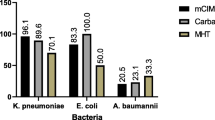Abstract
Carbapenemase-producing organisms (CPOs) pose a serious clinical threat and rapid detection tools are essential to aid in patient management. We developed rapid and simple molecular tests to detect blaNDM-type and blaVIM-type carbapenemase genes using recombinase polymerase amplification (RPA) combined with a lateral flow detection. The tests could provide results in approximately 15 min when using DNA extracts, with limits of detection of 9.2 copies/μl for the blaNDM-type assay and 7.5 copies/μl for blaVIM-type assay, and successfully detected all isolates harbouring the carbapenemase encoding genes in a panel of 57 isolates. These RPA tests may be suitable for use in low-resource settings to tailor rapid implementation of infection control precautions and antibiotic stewardship.
Similar content being viewed by others
Data availability
Data will be made available upon reasonable request.
References
CDC. Biggest Threats and Data. 2019 26-04-2021]; Available from: https://www.cdc.gov/drugresistance/biggest-threats.html.
WHO. WHO publishes list of bacteria for which new antibiotics are urgently needed. 2017 26-04-2021]; Available from: https://www.who.int/news/item/27-02-2017-who-publishes-list-of-bacteria-for-which-new-antibiotics-are-urgently-needed.
CDC. Clinicians: Information about CRE. 2019 26-04-2021]; Available from: https://www.cdc.gov/hai/organisms/cre/cre-clinicians.html.
WHO. Guidelines for the prevention and control of carbapenem-resistant Enterobacteriaceae, Acinetobacter baumannii and Pseudomonas aeruginosa in health care facilities. 2017 26-04-2021]; Available from: https://www.who.int/infection-prevention/publications/guidelines-cre/en/.
Banerjee R, Humphries R (2017) Clinical and laboratory considerations for the rapid detection of carbapenem-resistant Enterobacteriaceae. Virulence 8(4):427–439
World Health O (2019) Landscape of diagnostics against antibacterial resistance, gaps and priorities. World Health Organization, Geneva
Li J, Macdonald J, von Stetten F (2019) Review: a comprehensive summary of a decade development of the recombinase polymerase amplification. Analyst 144(1):31–67
James A, Macdonald J (2015) Recombinase polymerase amplification: emergence as a critical molecular technology for rapid, low-resource diagnostics. Expert Rev Mol Diagn 15(11):1475–1489
Piepenburg O et al (2006) DNA detection using recombination proteins. PLoS Biol 4(7):e204
Zhao Y et al (2015) Isothermal amplification of nucleic acids. Chem Rev 115(22):12491–12545
Crannell ZA, Rohrman B, Richards-Kortum R (2014) Equipment-free incubation of recombinase polymerase amplification reactions using body heat. PLoS One 9(11):e112146–e112146
Hu C et al (2017) Ultra-fast electronic detection of antimicrobial resistance genes using isothermal amplification and thin film transistor sensors. Biosens Bioelectron 96:281–287
Kalsi S et al (2017) A programmable digital microfluidic assay for the simultaneous Detection of multiple anti-microbial resistance genes. Micromachines 8(4):111
Nordmann P, Poirel L, Dortet L (2012) Rapid detection of carbapenemase-producing Enterobacteriaceae. Emerg Infect Dis 18(9):1503–1507
Li J, Pollak NM, Macdonald J (2019) Multiplex detection of nucleic acids using recombinase polymerase amplification and a molecular colorimetric 7-segment display. ACS Omega 4(7):11388–11396
James AS et al (2018) Ebolavirus diagnosis made simple, comparable and faster than molecular detection methods: preparing for the future. Virol J 15(1):75–75
Bordin A et al (2019) Evaluation of the SpeeDx Carba (beta) multiplex real-time PCR assay for detection of NDM, KPC, OXA-48-like, IMP-4-like and VIM carbapenemase genes. BMC Infect Dis 19(1):571
Doi Y (2019) Treatment options for carbapenem-resistant Gram-negative bacterial infections. Clin Infect Dis 69(Supplement_7):S565–S575
Bauer KA et al (2014) Review of rapid diagnostic tests used by antimicrobial stewardship programs. Clin Infect Dis 59(suppl_3):S134–S145
Beganovic M et al (2019) Interplay between rapid diagnostic tests and antimicrobial stewardship programs among patients with bloodstream and other Severe infections. The Journal of Applied Laboratory Medicine 3(4):601–616
Perez KK et al (2014) Integrating rapid diagnostics and antimicrobial stewardship improves outcomes in patients with antibiotic-resistant Gram-negative bacteremia. J Infect 69(3):216–225
Nordmann P, Poirel L (2019) Epidemiology and diagnostics of carbapenem resistance in Gram-negative bacteria. Clin Infect Dis 69(Supplement_7):S521–S528
Logan LK, Weinstein RA (2017) The epidemiology of carbapenem-resistant Enterobacteriaceae: the impact and evolution of a global menace. J Infect Dis 215(suppl_1):S28–S36
Acknowledgements
We thank Dr. Nicole Ertl, Dr. Cameron Buckley, Ms. Bushra Alharbi, Ms. Amanda Bordin, Dr. Kym Lowry, and Ms. Carolyn Pardo for their technical support.
Funding
This study was funded by the Children’s Hospital Foundation Innovator grant 50272. JM is the founder and a shareholder of BioCifer Pty Ltd, who was not involved in the study. PNAH has received research grants from MSD, Sandoz and Shionogi, as well as speaker’s fees from Pfizer and has served on an advisory board for Sandoz outside the submitted work. DLP has received research funding from Pfizer, Merck, and Shionogi and funding for advisory boards or speaking engagements from Merck, Pfizer, BioMerieux, Sumitomo, Accelerate, QPex, and Entasis, unrelated to this work. DMW reports research funding from SpeeDx Pty Ltd unrelated to the study. ADI has received research funding and teaching honoraria from Gilead Sciences inc. unrelated to this work. AKSA, ET, CYTW and CH, and HMZ have no competing interests to declare.
Author information
Authors and Affiliations
Contributions
Conceptualization: HZ, AI, JM, PH, CH, and DW. Methodology: AA, CW, JM, ET, and DW. Data analysis: AA, JM, and DW. Writing—initial draft: AA and DW. Writing—review and editing: DW, PH, AI, JM, HZ, CH, ET, DP.
Corresponding author
Ethics declarations
Ethical approval
Ethical approval for this work has been provided by the human research ethics committee at The University of Queensland HREC, approval 2018000615.
Additional information
Publisher’s note
Springer Nature remains neutral with regard to jurisdictional claims in published maps and institutional affiliations.
Supplementary Information
ESM 1
(DOCX 506 kb)
Rights and permissions
About this article
Cite this article
Ayfan, A.K.S., Macdonald, J., Harris, P.N.A. et al. Rapid detection of NDM and VIM carbapenemase encoding genes by recombinase polymerase amplification and lateral flow–based detection. Eur J Clin Microbiol Infect Dis 40, 2447–2453 (2021). https://doi.org/10.1007/s10096-021-04267-6
Received:
Accepted:
Published:
Issue Date:
DOI: https://doi.org/10.1007/s10096-021-04267-6




